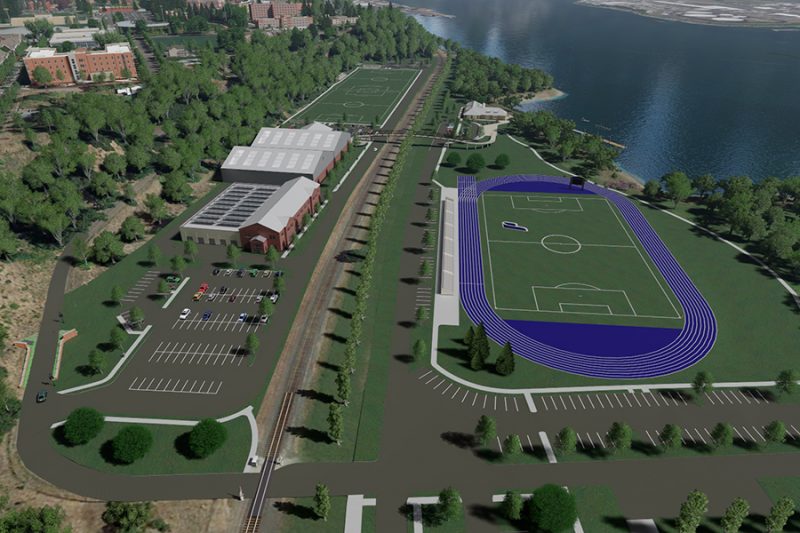
When the University of Portland announced a big campus expansion late last month, the question we immediately heard was: Where’s the trail?
“The University stands by its commitment to provide an 8′ easement from our property but cannot offer any additional land. The land to complete the trail must come from Union Pacific.”
— James Kuffner, University of Portland
The North Portland Greenway is a long-planned 10-mile path that will eventually connect the Eastbank Esplanade to Kelley Point Park. The alignment adopted by Portland City Council in 2013 runs alongside Union Pacific Railroad tracks (on University of Portland property) that run through the new campus; but none of the visuals released by the university show the trail. Advocates with the nonprofit NP Greenway are both excited and worried about the news. Construction of the new campus could mean a major breakthrough for a key section of their trail. But as any veteran trail advocate will tell you — there are no sure things when it comes to the complicated interplay of private developers, planning easements, and an all-powerful railroad company.
James Kuffner with University of Portland shared via email today they plan to set aside an eight-foot wide strip of land for the trail. But NP Greenway Board Member Francie Royce says the trail must be at least 14 or 16-feet wide. The legal standing of the easement also complicates things.
In response to an email yesterday from a concerned advocate, Kuffner said, “Not to worry – the NP Greenway Trail is alive and well at UP.” Kuffner added that they’ve only promised eight feet of width as a “contribution to the full width trail” and says more detailed drawings to be submitted as part of an upcoming greenway review application with Bureau of Development Services will show the trail easement.
Then Kuffner wrote, somewhat ominously, that the rest of the project will be up to Union Pacific. “The biggest challenge to building the trail is getting an easement from Union Pacific RR to provide the additional 6′ to 8′ of land so the trail can be built to the desired specifications and width. Until that happens I don’t believe construction of the trail is possible.” “The University stands by its commitment to provide an 8′ easement from our property but cannot offer any additional land. The land to complete the trail must come from Union Pacific,” he added.
Leaving the future of this trail in the hands of UPRR’s generosity isn’t exactly good news.
Advertisement
The consternation that remains has to do with who is obligated to give up land for the trail. Advocates and the City of Portland say it’s University of Portland. The university, via Kuffner, says it’s also UPRR.
The 2013 Greenway alignment adopted by City Council specifically notes that the trail in this segment needs to be at least 14-feet wide and that it, “runs parallel to, and south of, the UPRR rail line outside of the railroad ROW to the University of Portland property purchased for future campus expansion (River Campus).”
Here’s the alignment adopted by Council:
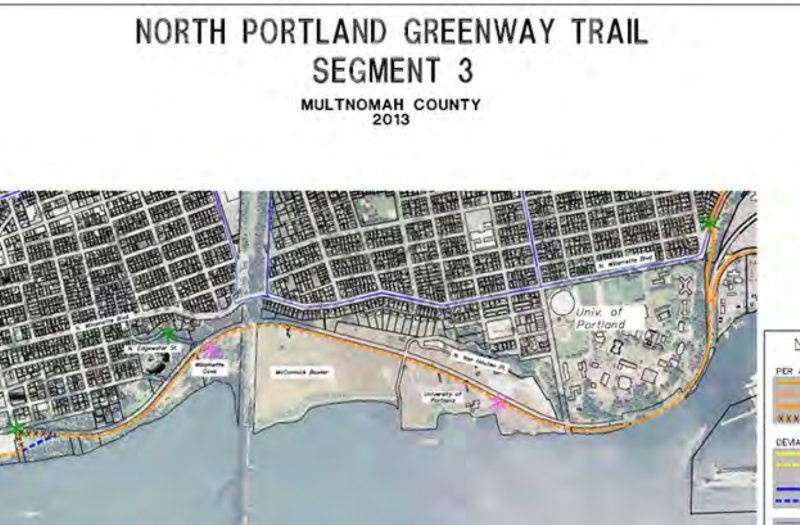
U of P’s 2012 Master Plan (PDF here) acknowledges that the North Portland Greenway requires a 12-14 foot wide trail with an additional three-foot buffer from the railroad tracks. Here’s the wording from their plan:
This recommended alignment will require dedication of more land from the University in addition to the 25-foot Greenway setback and it will bi-furcate the river campus with a public access. However, the University supports the objectives of the Greenway plan and the objectives of the trail access. As a result, the University supports the recommended trail alignment in Segment 3.
There’s nothing in their master plan that refers to the eight feet mentioned by Kuffner — nor does the plan make any requirements of Union Pacific as outlined in Kuffner’s comments today.
Here’s the image from U of P’s plan referred to above:

And for good measure, here’s the alignment shown in NP Greenway’s “vision”:
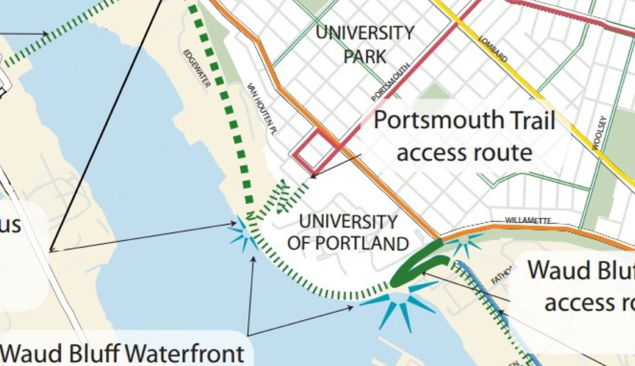
NP Greenway Board Member Cynthia Newton shared with us via email last week that, “The University will be required to build the npGreenway Trail per their master plan as part of the project… We are thrilled that this section of the Trail will be built in the foreseeable future.”
“We want to make sure that PP&R doesn’t miss this opportunity and that the University of Portland follows through with many reassurances of their commitment they have made over the years.”
— Francie Royce, NP Greenway
Another NP Greenway Board Member Francie Royce is still seeking assurances. “We’ve always been told by U of P representatives that they support and will build the trail once they build their river campus,” she shared with me via email today. “The adopted alignment runs along the riverside of the railroad tracks that cuts through the U of P property. The alignment is on U of P property – not Union Pacific property. PP&R [Portland Parks and Recreation] must make make sure they get a dedicated easement or dedicated property for at least a 14’ if not a 16’ trail built by U of P.”
As for what’s required by land-use law, it appears that U of P has no legal requirement to build the trail. It comes down to when they applied for permits to build the new campus. When they applied in August 2017, Portland’s 2035 Comprehensive Plan had been adopted by Council but it was not yet legally binding. The new Comp Plan wasn’t effective until December 2017 when it was approved by the Oregon Department of Land Conservation and Development. That means the City of Portland had to refer to the 1980 Comp Plan which places alignment of the greenway trail on North Willamette Blvd.
Royce and other advocates have worked closely with U of P for years. Now that there’s finally forward movement on this segment, they want to make sure the trail doesn’t end up in a door zone bike lane on Willamette instead of on the riverfront.
“We want to make sure that PP&R doesn’t miss this opportunity and that the University of Portland follows through with many reassurances of their commitment they have made over the years.”
Stay tuned.
— Jonathan Maus: (503) 706-8804, @jonathan_maus on Twitter and jonathan@bikeportland.org
Never miss a story. Sign-up for the daily BP Headlines email.
BikePortland needs your support.


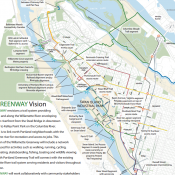
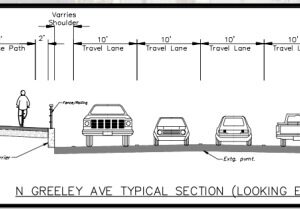
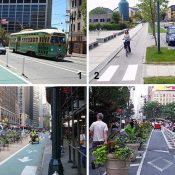
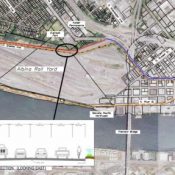
Thanks for reading.
BikePortland has served this community with independent community journalism since 2005. We rely on subscriptions from readers like you to survive. Your financial support is vital in keeping this valuable resource alive and well.
Please subscribe today to strengthen and expand our work.
Thanks for the great story! Why did PP&R choose a route that paralleled the RR tacks and not the top of the bank? I thought all new riverfront development was required to include an easement for a Willamette River Greenway trail, is that only in downtown? I think it was just yesterday that City Council killed a huge development in NW Portland because part of the building would have infringed on part of the greenway envelope. The Councilors, esp. Fritz, spoke passionately about advocating for the greenway and protecting our access to the rive- maybe its time to give them each a call and ask them to fight for North Portland as hard as they fought for the Pearl!
I knew absolutely nothing about this until reading the article, so was approaching it neutrally. I remained neutral for about 10 seconds, when I read the University’s statement that it “cannot offer any additional land”.
Of course it CAN. It just doesn’t WANT to.
If the University had said, “We don’t want to offer more than 8′ “, that would have been honest, and barring any legal issue, it has a right to not offer more–or to offer nothing, for that matter. Even saying, “We cannot offer any additional land without giving up some parking spaces (or having to live with narrower hallways, or less lawn, or whatever) and we’re unwilling to do that” would have been better than pretending it’s just not possible.
From the rendering, it looks like they’d have to give up about 30 parking spots to give the additional 8ft. I guess we know where their priorities are.
River side parking is the best parking. Cars love to lounge by the river on a sunny day and appreciate the flora and fauna of the pacific north west.
I thought it was pretty obvious that they meant “can not within the constraints of their plans for the property.”
I’m also a bit confused about the plans for the width. Is 14′ the actual width of pavement, or pavement plus some sort of buffers? If the latter, it doesn’t sound like the University is constraining the project at all. It’s very rare to find a multi-use path anywhere wider than 8 feet, and UP seems to have planters or other buffers along all their paths on campus. As far as I know, the downtown esplanades are the only example of 14′ wide paved paths in Portland.
Additionally, why is the bikeportland pretending Union Pacific granting an easement is an issue only for the segment crossing the University’s property? The segment between the University and Swan Island has to run entirely on Union Pacific property. It’s not a question of getting an easement from the railroad or only having an 8′ trail. It’s negotiate an easement with the railroad or have no trail at all. In fact, east of the university’s property, there’s barely 8′ there between the tracks (literally, the steel rails, not a safe distance from trains) and where the bank falls off towards the river, which is why that segment is actually planned to be built as a boardwalk. Along most of Waud Bluff, there’s barely room for the 18″ wide path joggers and cyclists have worn into the railroad ballast.
Personally, when I lived in that neighborhood, I would have been thrilled to have an 8′ wide trail along the proposed alignment. If the city can negotiate civilly with the University to find a way to contribute more land, that’s great, but the rest of the community needs to drop the attitude of blaming the University for making a perfectly adequate contribution.
Yes, of course it’s obvious to me and probably everyone else that they meant “can not within the constraints of their plans for the property”–which again, is still just another way of saying, “We could if we wanted to, but we don’t”.
And I wasn’t blaming or criticizing the University for what it’s offering. I was pointing out that the University’s saying “it cannot offer any additional land” is a disingenuous statement. The “constraints of their plans for the property” that are “preventing” them from offering more are constraints they’ve created for themselves, and that they can change if they want to.
And remember, this is a very large site. Adding 6′ to the easement isn’t a massive amount.
You’re statement that “It’s very rare to find a multi-use path anywhere wider than 8 feet” is just plain wrong. The new Willamette Greenway Trail segment through Willamette Park is about 12′ wide, and there’s another branch running parallel to it several yards away that’s 10′ wide, for a total width of pavement (not counting all the surrounding lawn that people walk on) of 22′. As that trail continues north, the pavement varies from about 8′ to about 10′ wide, but there’s an additional several feet alongside the pavement where many people prefer to run or walk. The new segment heading south from the park to the Sellwood Bridge is similarly wider than 8′.
The Parks Bureau’s standards for “major park paths or lengthy multi-use trails” is 12′ asphalt (8′ min- 14′ max) with additional room for fencing if along rail: https://www.portlandoregon.gov/parks/38306?a=250105
(see p. 12)
Due to environmental issues within the 25 foot Greenway zone along the River, the trail needs to be where it is planned…along the UPRR line, and the U of P Master Plan acknowledges this. It is my understanding that converting industrial land to non-industrial use along the river REQUIRES construction of the trail…see Swan Island where Feightliner, Boise Cascade, BES and Daimler have built trail sections over the years. On the former Triangle industrial land, U of P is required to build the trail.
“It is my understanding that converting industrial land to non-industrial use along the river REQUIRES construction of the trail”
I’ve heard this before, if it the path is truly a mandate tied to developing the land then this move by UP could be posturing to try and force Union Pacific to meet UP (literally) halfway on the path. If it was my project I think I’d give it a shot first before writing off 30 parking spots.
“Due to environmental issues within the 25 foot Greenway zone along the River, the trail needs to be where it is planned…along the UPRR line, …” lenny anderson
That being the case, siting the 16′ trail just north or the 25 foot Greenway zone would seem to make for a far safer, more beautiful and enjoyable MUP than it would be, aligned directly next to the rail line. In regards to environmental issues, which of the two: an asphalt biking and walking MUP, and the turf for a big running track with a soccer field, poses the greater threat of contamination to sensitive environmental areas? Turf is notoriously bad for the chemicals required to keep it picture perfect for sports games.
It’s too bad the public needs to rely on Parks when it comes to trails. Among several pretty unbelievable things for a Parks Bureau to do, Parks argued to City Council recently for closing trail segments in Washington Park by claiming that since there were public sidewalks on City streets outside the park, there was no loss to the public in closing trails in the woods. Before the hearing, Parks also removed several of its own trail signs, then claimed the trail they wanted to close was an “unofficial cut-through” rather than a designated trail with signage that appeared on Parks’ own trail maps.
I hope Parks will be the public’s advocate in this case, but wouldn’t be surprised if Parks sides with UP in any aspect where the University’s and public’s goals differ.
I believe that both City code and State law require that they not only provide the ROW for the greenway trail, but that they actually build the trail as well.
The quiet gorilla in the room, from looking at the rendering, is ‘just how wide is the UPRR ROW? We can see a representation of the rail bed and tracks. But how wide beyond that is the right of way corridor? Could it be that the envisioned trail is to the bluff side of that row of trees? If so, that looks wide enough to put a 16 foot trail without getting close to the rail bed. However, if the ROW extends until it is within 10 feet of the trees, then I can understand why UP says that the RR needs to provide some land to the deal.
Looking at the maps the railroad has a 40 to 50′ right of way through here. That would take it to the west side of the trees. You can see what looks like the 8′ section of path at the very bottom of the graphic provided by the university.
And I get where UofP is coming from here. They know as well as the railroad does that this section will remain single track forever. There is more than enough capacity, and even if the railroad did give up 8′ of ROW, they would likely still have enough space to double track at some point. This seems to be posturing. The real test will be if the railroad refuses. Will UofP capitulate?
Judging by the illustration at the top of the story, there seems to be plenty of room to include a 14′-16′ wide greenway path between the railroad and the road to the south of it (on the river side). Check out the wide green swath with the long allee of trees. Compare that width to the adjacent road (which would typically be 20-24′ wide). I think the University just doesn’t want to lose its long term options for campus expansion with more intensive use. That green space seems like a nice place to ride to me…
Looking at the drawings, my first impression was, “Oh my, that’s an awful lot of parking.” Then I remembered this little blurb: “Parking presents a daily challenge for students who drive to the University of Portland. Sophomore Natalie Nygren circled the parking lot for 30 minutes before giving up and driving home to walk four blocks back to campus.”
If your students would actually get into a car for a four block trip to campus, your institution has some problems. This may not end well.
http://www.upbeacon.com/article/2018/02/parking-struggle-campus
That’s just sad– she lives well within walking distance, and chooses to waste 30+ minutes driving in circles only to drive back home and walk the FOUR blocks back to school.
Why not just skip the 30+ minute circus and walk instead? Four blocks should take you way less time.
The article doesn’t give any compelling reasons why this particular student needs to drive to school, and the university does say that they won’t give parking permits to students who live within walking distance– why did they give her a parking permit? What is their “walking distance” distance?
Looks like I will be calling Mr. Kuffner to ask him why he doesn’t want to contribute the full width of the required path. If anyone else needs his number, it is: 503-943-7331
The story says UP is not legally required to build the trail, the comments say they are. Needs follow up and clarification.
A few of you have mentioned something about 30 parking spots being lost to support the trail- there’s nothing mentioning that in the article and, in fact, according to the best image available, the trail would be on the opposite side of the railroad track from the parking. So, prove to me that the trail has anything to do with parking spaces?
It sounds like the University of Portland is passing the buck now, so that if they don’t build it, they can point to Union Pacific instead of themselves for not standing behind it.
The trail would be on the river side. You can see a small section of UofP’s 8′ trail at the bottom of the main rendering. The “30 parking spaces” is just my estimate based on the rendering. If they wanted to maintain the frontage road west of the tracks and give an extra 8′ to the trail, they would have to sacrifice the perpendicular parking by the track; or, possibly shift the entire track further west (probably unlikely).
Maybe the University of Portland needs to return the $75,000 they recently received to do a bike study….
Hi Tim,
That grant went to Portland State University – not University of Portland.
People often confuse the two. One way to remember which is which is that PSU is the only one with a football team.
Maybe send your comments to the folks who gave the UP the grant? https://peopleforbikes.org/contact/
To me, it sounds like the NPG has a choice: accept an 8’ Wide corridor thru the U of P property, or force the city to route the Greenway along Willamette Blvd. Anything wider thru the U of P land requires permission from the UPRR. If the Greenway doesn’t get it, then Willamette is the only solution, based on the 1980 plan. So it’s possible that a decision made in 1980 might prevent the Greenway from being routed thru the U of P bluff in 2018. Someone should’ve realized this scenario in 1980, but nobody did. So Willamette, like it or not, likely becomes the Greenway route thru that area because nobody paid attention 38 years ago.
The trail is one thing. But my goodness those renderings make me want to weep a little. That is an amazing piece of realty, and they’re going to use it to build some athletic fields and parking spots (and one academic building!). What an absolute travesty.
Well, the city council just rejected a large development in the Pearl because it would create a pinch point on the waterfront path there. Perhaps the city council would do the same for this project to keep things fair and consistent.
“City leaders were most bothered by the width of the greenway between the building and the Willamette, down at one spot to just 13 feet. That’s too narrow for bikes, walkers and others to share; the city wants the path to be closer to 50 feet.”
http://www.kgw.com/article/news/local/portland-rejects-17-story-fremont-apartments-plan/283-526649869
Higher temps for the river and urban heat island effect.
*comment deleted*
Thanks for the comment Julio. I believe it’s your first one. Welcome! Unfortunately I had to delete it because it was sort of mean-spirited. I don’t like comments where it appears your sole purpose was to say how much you hate other commenters. Try again please! I’d love to be able to share your thoughts here. Thanks!
I think it is important to recognize that the University purchased this land as a Superfund site, so they are limited in what they can build on the property due to prior pollution.
As a current student, I would like to comment that the University currently does not have enough parking for students, faculty, staff, and attendants of the numerous events that the University kindly holds for the public. And it is not as much as walking four blocks, as many students commute from areas such as Beaverton and Happy Valley. If you live within four blocks of the campus you cannot even park on the campus! However, when students do park in the neighborhood, people complain that the congestion, so our campus community does need more parking.
Additionally, we need more athletic fields as many intramural teams have to practice at 11pm and it is only logical that the university finally builds a track to serve its incredibly talented cross country and track teams.
While I am incredibly excited about the Greenway trail and have been a supporter of it since I have started attending the University, the University is doing a great job at recognizing the needs of its growing student population in this plan.
There is a high cost for free car parking. A book was written about it. There is not enough public transit.
Free parking is far more attractive than free camping! More productive too.
Back when I was a student at UP (class of 1982), that piece of property wasn’t yet a superfund site, because it was still an active industrial area.
By the way, there was even less parking in those days. The lot off of Peninsula wasn’t yet even a dream as all the land to the north of the campus was privately owned. Also we did have a track, but it went the way of the Dodo when the current soccer complex was built.
Lastly, just because a student lives within four blocks of campus doesn’t mean that they are just commuting that distance. Many of UP’s students have jobs in the Portland Metro region that they go to after classes are over for the day.
So if a student lives four blocks away, but has a job after classes, and wants to drive to it, why can’t they just leave their car at home, and walk the four blocks home to get in their car and drive to work? You’re not making a very compelling argument for the school needing to provide them with an on-campus parking space.
Commuting from Beaverton and Happy Valley in a car is a choice that is already overly subsidized without turning riverfront property into parking lots.
so wait, the river trail will not be on the river, and the only viable natural surface trail connection will now be developed over. We will soon be a land of asphalt and we wont need bikes, we will be able to rollerblade everywhere.
Hi Steve, the University of Portland is as excited about the North Portland Greenway Trail as you and our students, faculty, and staff are, and we’ve all been waiting a long time to see it completed. We don’t think there is any controversy. Our staff were already meeting with members of the npGreenway committee in 2008, the year UP purchased the property, to express our support and commitment to the trail. After spending over $6 million in environmental cleanup, the University began work on its Master Plan, including the future Franz Campus. We have anticipated the trail alignment in all our work on the campus to ensure that it could be accommodated once the trail alignment was adopted by Portland’s City Council. We remained as committed as ever to the trail and look forward to its future completion!
This sounds like you’re commenting as a representative of the University. Is that true? If so, it seems odd that your comments differ so much from the information in the article. You say the University remains committed to the trail, and that the University has planned that it can be accommodated, but the article states that the University is only allowing 8′ for the trail, which is not wide enough for it without the railroad also cooperating to create additional width. Can you explain why your description of how things stand is so different than the information from the University that’s in the article?
This was a response to me (Steve) from the UP Facebook page.
Steve–thanks. I wondered why it said, “Hi Steve”. After reading the article, the answer they gave you seems like a typical “Everything’s fine” PR-speak answer. When I get answers like that, I always feel like the person who wrote it’s job is to quiet down any controversy and nip any potential opposition in the bud. The problem is that if there IS a problem, like the width in this case, it just kicks the problem down the road where it becomes harder to solve.
eyesore for a riverfront property
npGreenway is the ‘signature’ trail demanded when the 2040 Bicycle Master Plan was recommended by the Planning Commission and passed by Council. Every turn seems to distill, diminish or deny that “signature trail’. The challenge of npGreenway, as well as the residents of North Portland particularly, is not allowing this trail to slip away. As 5000 jobs start soon at Amazon at Terminal 5, expect gridlock on Marine Drive,Lombard and Willamette Blvd, as well as US30 and the SJ Bridge. Its bad already. Its gonna be a mess. npGreenway being completed to provide at least a partial solution is a good value.
This article states 1,000. And I assume that’ s for multiple shifts, not 1000 showing up and leaving at the same time. Not to say I don’t agree with your sentiment, I just had a mild panic reading your number, as I live close by.
http://www.oregonlive.com/business/index.ssf/2017/09/amazon_to_open_north_portland.html
I think it’s important to remember that this land was a Superfund site. UP bought it years ago and was responsible for cleaning it up. It’s not public land. UP is going to do right by its students (customers) and if they need more parking places, they’re going to put them in. It’s such a pain in the ass to do business in PDX. Not only the taxes for the city and county but this area is so anti-business because of the constant nit-picking and complaining by many of its citizens.
I’m not sure why the Superfund designation is relevant to the bike path. It’s great UP is paying to clean it up, but on the other hand isn’t that something it (or any buyer) would have anticipated, and wouldn’t the purchase price reflect that?
Everyone knows it’s not public land. But being private doesn’t (and shouldn’t) give an owner carte blanche to do whatever they want. Portland (and Oregon) are hardly the only places that have restrictions on building new parking (especially on waterfront land) or requirements for extending public transportation infrastructure through a site.
And this site has been identified as a location where the trail should be extended for decades, and so has the fact that the width needs to be more than 8′. Concern about the University now saying they won’t accommodate that width now isn’t nitpicking.
And the high-tax argument falls a bit flat given that the University is exempt from many of those taxes.
Unless you go to UP or are planning to go to UP, unless you’re an UP employee or a donor, the school is not focused on you. Sorry, that’s just the way it is. There’s a big difference between doing “whatever they want” carte blanche and balking at widening a trail at the potential risk of losing parking. People can deal with biking on an 8 ft. wide trail. Just be glad it’s there in the first place.
There are all kinds of requirements placed on owners of properties that require things that owners may not want, but that doesn’t mean they’re not legitimate requirements, or that people who are not owners or customers/clients/employees/donors/students cannot legitimately ask for them.
Examples–accessible parking spaces, landscaping around buildings or parking lots, fences around apartment trash areas, walkways of certain widths with specific maximum slopes and levels of illumination connecting buildings to nearby public sidewalks…Anyone can legitimately ask a private property owner to provide those, and in fact the owner is legally required to provide them whether they want to or not.